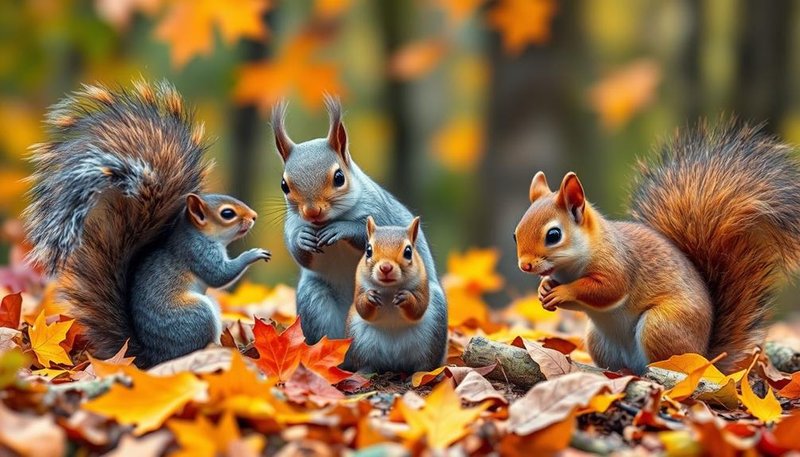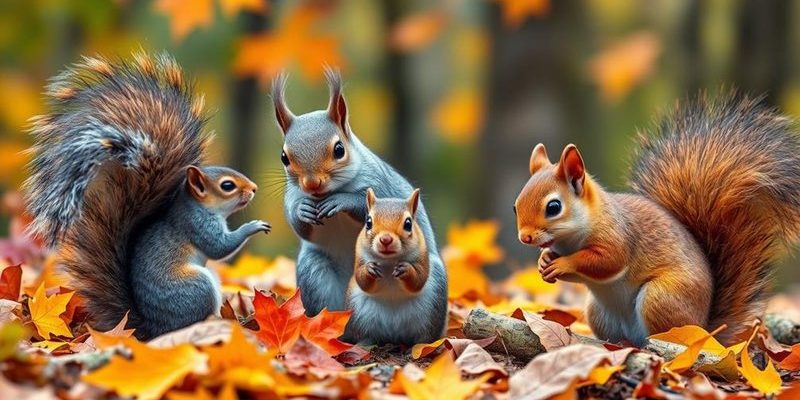
In this article, we’ll explore ten animals that share similarities with squirrels and help you figure out how to tell them apart. Think of it as a mini travel guide through the animal kingdom—each stop offering a unique twist and some handy tips on identification. Whether you’re a budding wildlife enthusiast, a curious observer, or just someone looking to impress friends with newfound knowledge, you’re in for a treat!
1. Chipmunks
Chipmunks are probably the most well-known relatives of squirrels. You might spot these small, striped furballs darting about on the ground or quickly scurrying up trees. The key difference? Chipmunks have distinct vertical stripes running down their backs, which sets them apart from their bushy-tailed cousins.
These little guys have a cheeky personality and are often seen gathering food to stash away for the winter. If you see a tiny critter repeatedly darting back and forth, you’re most likely watching a chipmunk gathering its treasure!
Identifying Chipmunks
To identify a chipmunk:
- Size: Smaller than a typical squirrel, usually just 9-10 inches long.
- Stripes: Look for the signature black and brown stripes along their back.
- Habitat: Prefer ground level and burrow into the soil.
2. Prairie Dogs
Next up are prairie dogs. They might not look like squirrels at first glance, but they share that same playful, sociable spirit. Found in the grasslands of North America, prairie dogs live in colonies and communicate with each other using a series of chirps and barks.
The biggest difference? Prairie dogs are much bulkier and have shorter tails—definitely not the fluffy kind you’re used to seeing with squirrels. You might even catch a glimpse of them standing upright, scanning their environment for potential dangers.
Identifying Prairie Dogs
To spot a prairie dog:
- Body Shape: Stockier and heavier build than squirrels.
- Tails: Shorter, stubby tails that don’t provide the same fluffiness.
- Living Arrangements: Often seen in large colonies, dug into the ground.
3. Tree Rats
Tree rats, often confused for squirrels due to their similar habitats and behaviors, can be a little deceptive. While they have bushy tails and a knack for climbing, they generally have a more robust build and a less vibrant coat.
These creatures are usually found in urban settings—think of them as the “city version” of squirrels. If you notice a more robust, less animated creature munching on food scraps in a park, it’s worth taking a second look!
Identifying Tree Rats
Look for these features to distinguish tree rats:
- Size: More robust and larger than most squirrels.
- Fur: Often duller in color compared to the vibrant fur of squirrels.
- Behavior: Less agile and skittish than the typical squirrel.
4. Flying Squirrels
Flying squirrels may sound like a fantastical creature, but they’re very much real! These nocturnal animals glide between trees using a special membrane of skin stretched between their limbs. If you spot one at night, you might think you saw a bird take flight until you realize it’s a gliding squirrel!
What sets flying squirrels apart from regular squirrels is their size and distinctive gliding ability. They are often smaller and have a flatter face, which can make them look super cute!
Identifying Flying Squirrels
To identify these quirky creatures:
- Size: Smaller body, with some species measuring around 10 inches.
- Face: Flatter face with big eyes—perfect for their night-time adventures!
- Gliding: Look for them gliding gracefully from tree to tree.
5. Guinea Pigs
Guinea pigs are often kept as pets, and while they’re not wild animals like squirrels, they do share some behavior traits. For instance, they’re social, curious, and have a knack for gathering food—similar to squirrels foraging for acorns.
However, guinea pigs are much rounder and don’t have the climbing abilities of their squirrel relatives. They’re also distinct in that they lack long tails, making them quite different in appearance.
Identifying Guinea Pigs
When spotting guinea pigs, look for:
- Size: Round and chunky bodies, typically around 8-10 inches long.
- Tails: No tails—definitely a giveaway!
- Behavior: Ground-dwelling and often seen in pairs or small groups.
6. Sugar Gliders
Sugar gliders are another gliding creature that resembles flying squirrels but with a few notable differences. Found in Australia and New Guinea, these small marsupials are known for their sweet, friendly demeanor. They have large, expressive eyes and are often kept as pets due to their playful nature.
While they closely resemble flying squirrels, sugar gliders are slightly smaller and have a unique coloration with a lighter belly—a cute little twist to their appearance!
Identifying Sugar Gliders
To spot sugar gliders, note the following:
- Size: Generally smaller than flying squirrels, about 5-6 inches long.
- Color: Lighter belly with a darker back fur.
- Behavior: Very social and often make chattering sounds.
7. Woodchucks
Woodchucks, or groundhogs, are larger relatives of squirrels often found in suburban areas. Unlike squirrels, they spend most of their time on the ground rather than in trees. These hefty little guys can really fill out a garden if you’re not careful!
You might confuse them with squirrels due to their furry appearance, but woodchucks are more stocky and have shorter tails. They also have a habit of standing on their hind legs, which is typical behavior when they’re maintaining watch.
Identifying Woodchucks
Here’s how to tell woodchucks apart:
- Body Type: Much stockier build than squirrels with a heavier body.
- Tails: Short and stubby tails, unlike the bushy tails of squirrels.
- Habitat: Ground-dwellers, often found burrowing in yards.
8. Lemurs
Lemurs are fascinating primates that might not look too similar to squirrels on the surface, but they share certain behavioral traits. These creatures are incredibly social and can be quite agile despite their size. Most notably, lemurs have long tails that they use for balance while leaping from branch to branch, somewhat reminiscent of how squirrels move about.
While lemurs are larger and come in various species, they can be playful and curious—traits you’ll also find in squirrels.
Identifying Lemurs
To spot lemurs, look for:
- Size: Generally larger than squirrels, with sizes up to 24 inches.
- Tails: Long, fluffy tails often striped in some species.
- Social Behavior: Very vocal and social in their groups.
9. Mice
While mice are much smaller than squirrels, they share a similar habitat and can often be found in gardens and parks. Mice are quick and elusive, much like the more agile squirrel, but they don’t have the bushy tails or the playful antics that we associate with their larger cousins.
One of the significant differences is size and fur texture—mice generally have a sleeker appearance compared to the fluffy fur of squirrels. When you see a little creature scurrying away quickly, it might just be a mouse!
Identifying Mice
To identify mice, keep these points in mind:
- Size: Significantly smaller, usually just a few inches long.
- Tails: Long, thin tails that lack fluffiness.
- Behavior: Quick, darting movements and prefer to hide.
10. Nutria
Nutria, or coypu, are large, semi-aquatic rodents that often confuse people when compared to squirrels. They have thick fur and a long, round tail, but their habitat is quite different. Nutria are often found near water bodies and are recognized by their webbed feet.
Unlike squirrels, these animals are primarily herbivores and enjoy munching on aquatic plants. If you see a large animal swimming in a lake, it is more likely to be a nutria than a squirrel!
Identifying Nutria
When identifying a nutria, look for:
- Size: Much larger than squirrels, can weigh up to 20 pounds.
- Tails: Long, round tails that are not bushy.
- Habitat: Often found in wetland areas and around rivers.
As you can see, many animals share traits with squirrels, but each has its own unique characteristics. Whether it’s the playful chipmunk or the social lemur, wildlife is full of surprises. The next time you’re out in nature, take a moment to observe the animals around you—you might just spot one of these squirrel-lookalikes!
Understanding how to tell these animals apart not only enhances your wildlife-watching experiences but also deepens your appreciation for the diversity of nature. So grab your binoculars, head outside, and enjoy the show!

